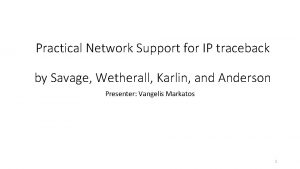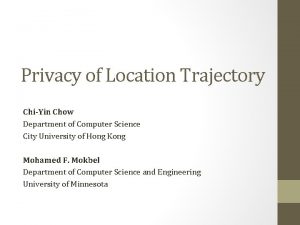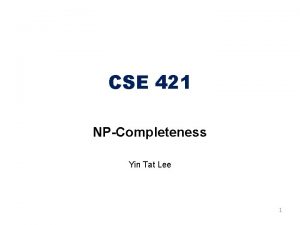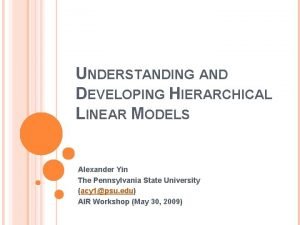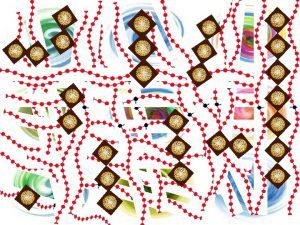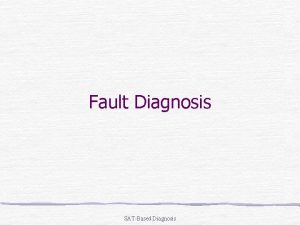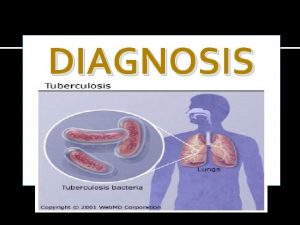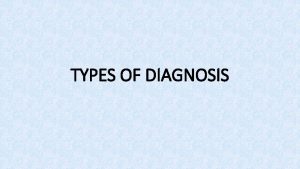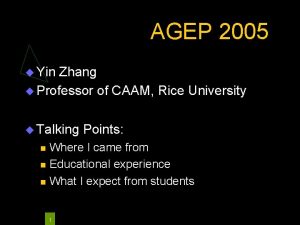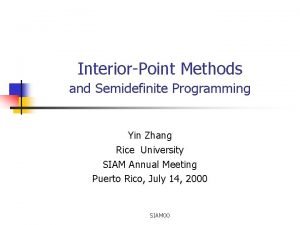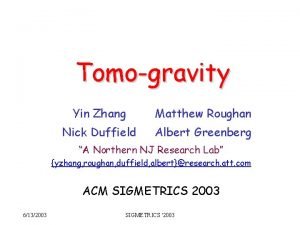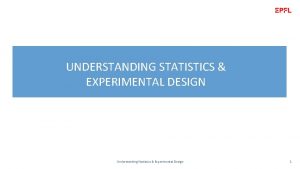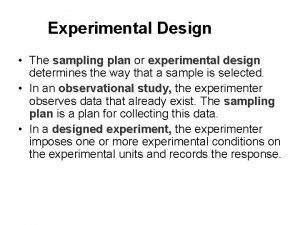Experimental Design for Practical Network Diagnosis Yin Zhang

























- Slides: 25

Experimental Design for Practical Network Diagnosis Yin Zhang University of Texas at Austin yzhang@cs. utexas. edu Joint work with Han Hee Song and Lili Qiu MSR Edge. Net Summit June 2, 2006

2 Practical Network Diagnosis • Ideal – Every network element is self-monitoring, self-reporting, self-…, there is no silent failures … – Oracle walks through the haystack of data, accurately pinpoints root causes, and suggests response actions • Reality – Finite resources (CPU, BW, human cycles, …) cannot afford to instrument/monitor every element – Decentralized, autonomous nature of the Internet infeasible to instrument/monitor every organization – Protocol layering minimizes information exposure difficult to obtain complete information at every layer Practical network diagnosis: Maximize diagnosis accuracy under given resource constraint and information availability

3 Design of Diagnosis Experiments • Input – A candidate set of diagnosis experiments • Reflects infrastructure constraints – Information availability • Existing information already available • Information provided by each new experiment – Resource constraint • E. g. , number of experiments to conduct (per hour), number of monitors available • Output: A diagnosis experimental plan – A subset of experiments to conduct – Configuration of various control parameters • E. g. , frequency, duration, sampling ratio, …

4 Example: Network Benchmarking • 1000 s of virtual networks over the same physical network • Wants to summarize the performance of each virtual net R R R – E. g. traffic-weighted average of individual virtual path performance (loss, delay, jitter, …) – Similar problem exists for monitoring per-application/customer performance • Challenge: Cannot afford to monitor all individual virtual paths R R – N 2 explosion times 1000 s of virtual nets • Solution: monitor a subset of virtual paths and infer the rest • Q: which subset of virtual paths to monitor?

5 Example: Client-based Diagnosis • Clients probe each other • Use tomography/inference to localize trouble spot C& W AOL Sprint UUNet AT&T Qwest Why is it so slow? – E. g. links/regions with high loss rate, delay jitter, etc. • Challenge: Pair-wise probing too expensive due to N 2 explosion • Solution: monitor a subset of paths and infer the link performance • Q: which subset of paths to probe?

6 More Examples • Wireless sniffer placement – Input: • A set of locations to place wireless sniffers – Not all locations possible – some people hate to be surrounded by sniffers • Monitoring quality at each candidate location – E. g. probabilities for capturing packets from different APs • Expected workload of different APs • Locations of existing sniffers – Output: • K additional locations for placing sniffers • Cross-layer diagnosis – Infer layer-2 properties based on layer-3 performance – Which subset of layer-3 paths to probe?

7 Beyond Networking • Software debugging – Select a given number of tests to maximize the coverage of corner cases • Car crash test – Crash a given number of cars to find a maximal number of defects • Medicine design – Conducting a given number of tests to maximize the chance of finding an effective ingredient • Many more …

8 Need Common Solution Framework • Can we have a framework that solves them all? – As opposed to ad hoc solutions for individual problems • Key requirements: – Scalable: work for large networks (e. g. 10000 nodes) – Flexible: accommodate different applications • Differentiated design – Different quantities have different importance, e. g. , a subset of paths belong to a major customer • Augmented design – Conduct additional experiments given existing observations, e. g. , after measurement failures • Multi-user design – Multiple users interested in different parts of network or have different objective functions

9 Net. Quest • A baby step towards such a framework – “Net. Quest: A flexible framework for large-scale network measurement”, Han Hee Song, Lili Qiu and Yin Zhang. ACM SIGMETRICS 2006. • Achieves scalability and flexibility by combining – Bayesian experimental design – Statistical inference • Developed in the context of e 2 e performance monitoring • Can extend to other network monitoring/ diagnosis problems

10 What We Want A function f(x) of link performance x – We use a linear function f(x)=F*x in this talk Ex. 1: average link delay x 2 f(x) = (x 1+…+x 11)/11 3 2 x 4 x 1 x 3 Ex. 2: end-to-end delays x 5 x 6 4 5 1 x 10 x 11 6 x 7 x 9 x 8 7 Apply to any additive metric, eg. Log (1 – loss rate)

11 Problem Formulation What we can measure: e 2 e performance Network performance estimation – Goal: e 2 e performance on some paths f(x) – Design of experiments • Select a subset of paths S to probe such that we can estimate f(x) based on the observed performance y. S, AS, and y. S=ASx – Network inference • Given e 2 e performance, infer link performance • Infer x based on y=F*x, y, and F

12 Design of Experiments • State of the art – Probe every path (e. g. , RON) • Not scalable since # paths grow quadratically with #nodes – Rank-based approach [sigcomm 04] • Let A denote routing matrix • Monitor rank(A) paths that are linearly independent to exactly reconstruct end-to-end path properties • Still very expensive • Select a “best” subset of paths to probe so that we can accurately infer f(x) • How to quantify goodness of a subset of paths?

13 Bayesian Experimental Design • A good design maximizes the expected utility under the optimal inference algorithm • Different utility functions yield different design criteria – Let , where matrix of x – Bayesian A-optimality is covariance • Goal: minimize the squared error – Bayesian D-optimality • Goal: maximize the expected gain in Shannon information

14 Search Algorithm • Given a design criterion , next step is to find s rows of A to optimize – This problem is NP-hard – We use a sequential search algorithm to greedily select the row that results in the largest improvement in – Better search algorithms?

15 Flexibility Differentiated design – Give higher weights to the important rows of matrix F Augmented design – Ensure the newly selected paths in conjunction with previously monitored paths maximize the utility Multi-user design – New design criteria: a linear combination of different users’ design criteria

16 Network Inference Goal: find x s. t. Y=Ax Main challenge: under-constrained problem L 2 -norm minimization L 1 -norm minimization Maximum entropy estimation

17 Evaluation Methodology Data sets # nodes # overlay nodes # paths # links Rank Planet. Lab-RTT 2514 61 3657 5467 769 Planetlab-loss 1795 60 3270 4628 690 Brite-n 1000 -o 200 1000 200 39800 2883 2051 Brite-n 5000 -o 600 5000 600 359400 14698 9729 Accuracy metric

Comparison of DOE Algorithms: Estimating Network-Wide Mean RTT A-optimal yields the lowest error. 18

Comparison of DOE Algorithms: Estimating Per-Path RTT A-optimal yields the lowest error. 19

Differentiated Design: Inference Error on Preferred Paths Lower error on the paths with higher weights. 20

Differentiated Design: Inference Error on the Remaining Paths Error on the remaining paths increases slightly. 21

22 Augmented Design A-optimal is most effective in augmenting an existing design.

23 Multi-user Design A-optimal yields the lowest error.

24 Summary Our contributions – Bring Bayesian experimental design to network measurement and diagnosis – Develop a flexible framework to accommodate different design requirements – Experimentally show its effectiveness Future work – Making measurement design fault tolerant – Applying our technique to other diagnosis problems – Extend our framework to incorporate additional design constraints

25 Thank you!
 Experimental vs non experimental
Experimental vs non experimental Experimental vs non experimental
Experimental vs non experimental Experimental vs non experimental
Experimental vs non experimental Disadvantages of experimental research
Disadvantages of experimental research Experimental vs non experimental
Experimental vs non experimental Actual nursing diagnosis
Actual nursing diagnosis Medical diagnosis and nursing diagnosis difference
Medical diagnosis and nursing diagnosis difference Types of nursing diagnosis
Types of nursing diagnosis Types of nursing diagnoses
Types of nursing diagnoses Perbedaan diagnosis gizi dan diagnosis medis
Perbedaan diagnosis gizi dan diagnosis medis Ece 526
Ece 526 Practical network support for ip traceback
Practical network support for ip traceback Yin yang marketing
Yin yang marketing Chi-yin chow
Chi-yin chow Yin characteristics
Yin characteristics Qoidali harakatli o'yinlar
Qoidali harakatli o'yinlar Jarangli undoshlar
Jarangli undoshlar Meridianos yin
Meridianos yin Yin e yang masculino e feminino
Yin e yang masculino e feminino Yin energy characteristics
Yin energy characteristics Yin tat lee
Yin tat lee Yin yang fish dish
Yin yang fish dish Alexander yin
Alexander yin Mike yin new zealand
Mike yin new zealand Wenyan yin
Wenyan yin Robert yin case study
Robert yin case study











